
DDR5 XPM and EXPO profile benchmarks …
Quickly to the right benchmark results …
Disclaimer
DDR5 initial results
Benchmark results DDR5- 5200 AUTO
Load EXPO profile
Benchmark results EXPO-6400
EXPO profile conclusion
Disclaimer …
Overclocking the PC is always at your own risk. Even if we provide detailed instructions here and act to the best of our knowledge and belief, there is always a risk of data loss or damage to the PC if it is operated outside the values specified by the manufacturer. We recommend using a separate Windows installation on a separate SSD for overclocking attempts so that the operating system is not affected. In addition, every PC behaves differently due to different equipment and manufacturing tolerances when operating at the limit. Therefore, you always do this at your own risk! If a PC no longer starts because it has been overclocked, the BIOS of the mainboard must be reset. There is now often a button on the rear I/O panel or a jumper on the mainboard for this purpose. If necessary, the button cell can also be removed from the mainboard for a few seconds and the mains cable unplugged. The mainboard then reboots with the default settings. Stable running configurations should always be saved as a profile in the BIOS or externally so that you can easily access them later without having to remember which settings have been changed up to that point.
DDR5 Initial results …
First, we determine the speed of the RAM out of the box – i.e. with freshly installed RAM, without performing any overclocking in the BIOS. It should be noted that even activating the XMP or EXPO profile already counts as overclocking and the system can already run unstably by activating the EXPO profile. AMD guarantees a maximum memory speed of 5200MT/s for Ryzen 7000 processors and 5600MT/s for Ryzen 9000. However, AMD also recommends EXPO kits with 6000MT/s for optimum performance and advertises compatibility for EXPO kits with speeds of up to 8000MT/s. The following image shows the automatic configuration after installing the RAM. The memory speed with our Ryzen 7 7800X3D processor is 5200MT/s.
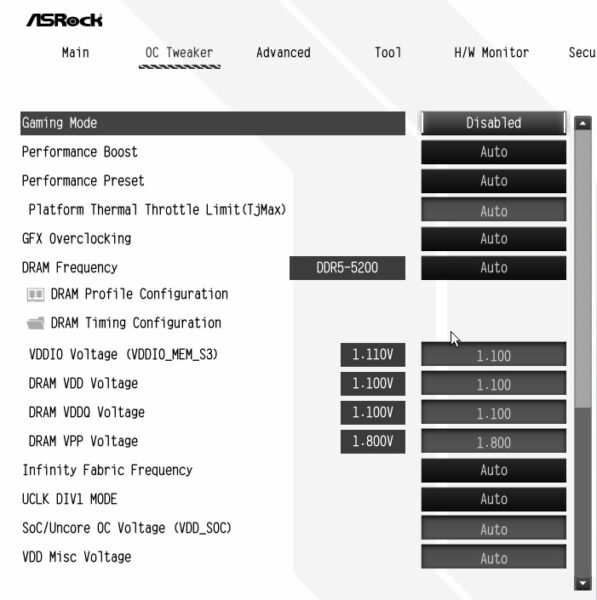
At memory speeds of up to 6000MT/s, the processor’s memory controller (IMC) works 1:1 with the frequency of the main memory (MCLK). With our 5200MT/s, this corresponds to 2600MHz. Most memory controllers manage 3000MHz (UCLK) without any problems, but problems can occur above this. Our Ryzen 7800X3D, for example, no longer works flawlessly at UCLK 3200. Another important factor for the performance of the RAM is the Infinity Fabric, or rather its clock frequency, the Infinity Fabric Clock (IFC, or FCLK). In our case, with DDR5-5200, it is set to 1733MHz by the mainboard as standard.
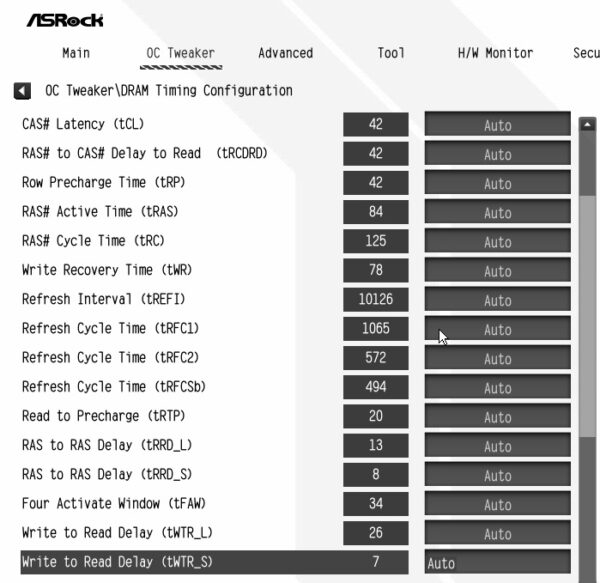
The ZenTimings program provides all important memory-related parameters for Ryzen systems at a glance.
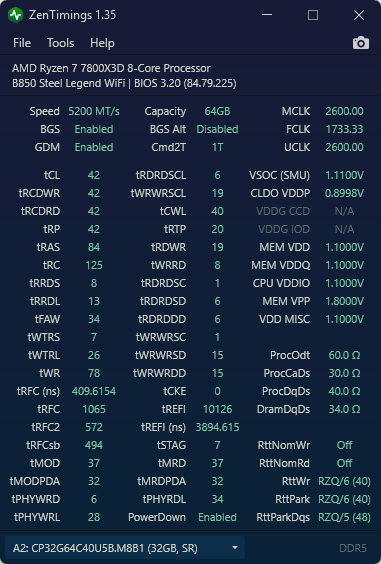
Benchmark results DDR5-5200 AUTO …
Using the Cache & Memory Benchmark from AIDA64, we determined the following average transfer rates and latency of the RAM. The higher the transfer rate, the better. Lower values are better for latency (delay).
AIDA Cache & Memory Benchmark
Read rate: 49,430 MB/s
Write rate: 65,820 MB/s
Copy rate: 49,500 MB/s
Latency: 93.6 ns
We use the CPU benchmark integrated in 3D Mark Time Spy to evaluate the gaming performance and determined the following score as the initial value before overclocking. The higher the score, the better.
Time Spy CPU-Score: 11.492 Points
As a final performance test, we use the memory benchmark integrated in the DRAM Calculator for Ryzen program. The faster this test is completed, the better. At 5200MT/s, the test took the following amount of time.
Ryzen DRAM-Calc Benchmark: 101,4 Sekunden.
We have now determined our initial values with the non-overclocked system and will now change certain parameters step by step and determine the effects on performance.
Load EXPO Profile …
Memory intended for high-performance PCs is usually equipped with an XPM or EXPO profile, which tells the mainboard which memory parameters should be adjusted to increase performance when the profile is activated. Our Crucial test sample has both XMP and EXPO profiles with different memory frequencies.
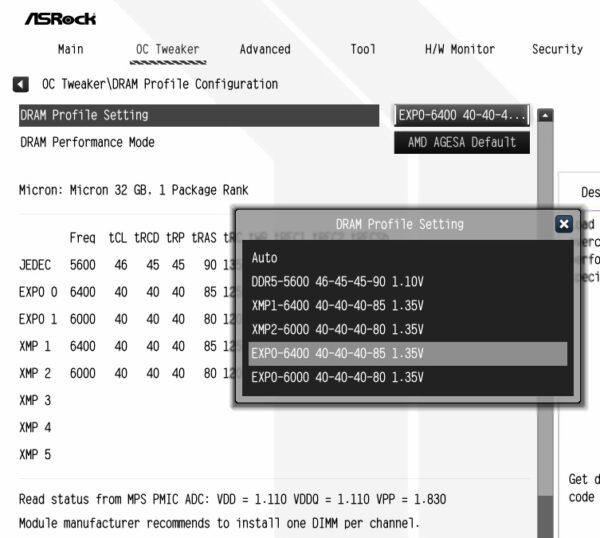
We naturally select the fastest profile with 6400MT/s. This increases the memory frequency (MCLK) to 3200MHz, but by default the clock frequency of the memory controller UCLK is reduced to 1600MHz (UCLK = MCLK/2). The Infinity Fabric still clocks at 2000MHz.
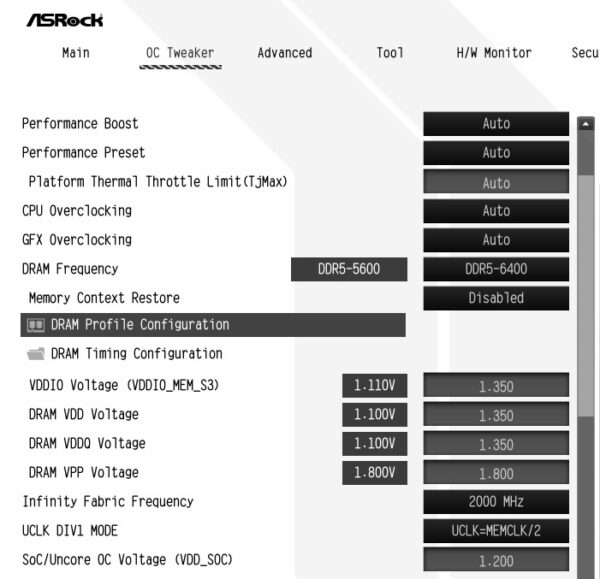
ZenTimings clearly shows us which memory timings have been changed by loading the EXPO profile and the clock frequency of the memory controller – UCLK 1600 MHz – is also displayed correctly.
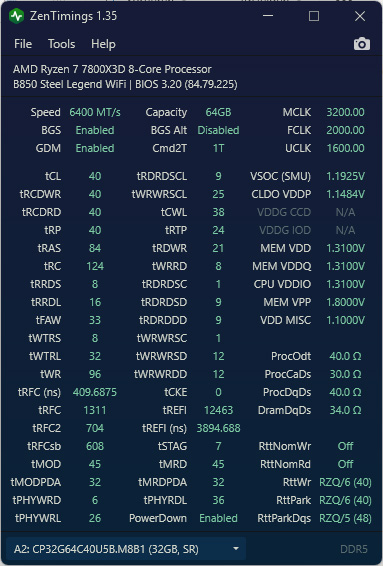
Benchmark results EXPO-6400 …
After activating the EXPO-6400 profile in the BIOS, we achieved the following measured values. The change in percent compared to the initial values with DDR5-5200 is shown in brackets.
AIDA Cache & Memory Benchmark
Read rate: 57,100 MB/s (+16%)
Write rate: 79,690 MB/s (+21%)
Copy rate: 57,170 MB/s (+15%)
Latency: 82.5 ns (-12%)
The measured values of the AIDA benchmark improve by a whopping 12 to 21% after activating the EXPO profile. This also gives hope for good results for the following benchmarks.
The gaming benchmark delivers the following score with EXPO6400.
Time Spy CPU-Score: 12.222 Points (+6%)
With an increase of 6%, the performance increase in the gaming benchmark is quite impressive. However, our last test shows the biggest improvement.
Ryzen DRAM-Calc Benchmark: 85.9 seconds (-15%)
The Ryzen DRAM Calc benchmark apparently benefits from both the increased bandwidths and the reduced latency, which is why this benchmark could even be completed 15% faster than with DDR5-5200 and AUTO settings.
Conclusion on the EXPO profile …
The measured values we determined clearly show that you should always activate the EXPO or XMP profile stored on the memory modules in the motherboard’s BIOS if computing speed is a priority. However, there are other ways to increase the PC’s operating speed that can be carried out in the PC’s BIOS with just a few clicks, without having to be a computer professional. We will reveal what these are in the next few steps.
DDR5 Infinity Fabric, IMC, Timings Tuning …

